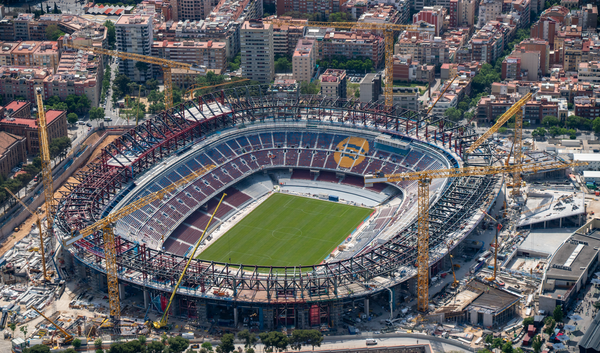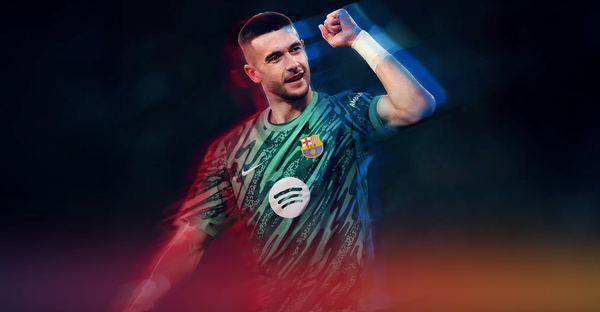The anatomy of the rise and fall of Marc-André ter Stegen
Ter Stegen’s technique has become inconsistent which before, he could make up for, in sheer athleticism and power

Just as is the case with defenders, analysing goalkeepers is a very difficult job. Only recently have we started experimenting with some advanced goalkeeper data that helps us understand and explain the role better. And while we’re now beyond rating goalies just by the goals they (don’t) concede, it will still take some time until we’re finally ready to analyse them with the same attention to detail as is the case with other positions. However, in football, almost nothing can be dissected in isolation.
A great goalkeeper can minimise the damage a very bad defence can do but even such high-quality individuals can only do so much. In the end, it’s their net that’s being rattled and their individual statistics suffer because of a lacking collective. This is true for every player on the pitch but arguably affects goalkeepers the most. However, there are certain aspects that are unique to their role and completely independent from the rest of the team. Aspects such as set positions, diving techniques, timing or simply choosing how to make a save.
Marc-André ter Stegen used to be a master of all of those. Or at least, it seemed that way. The German had fought his way up the ladder, dethroning Claudio Bravo to become Barcelona’s number one goalie for the last six seasons, including the ongoing 2021/22. But just as he was supposed to enter the Catalan folklore and mark a whole era with the Azulgranas, his performances started to dip. So much so that his continuity at the club - or at the very least his starting position - is not a guarantee anymore.
Yes, Barcelona’s defence is still as shaky as ever but as I’ve mentioned before, there are certain fundamentals every goalie has to have regardless of the quality of his backline. So in this analysis, I’ll dive deeper into Ter Stegen’s ‘fundamentals’ and some more advanced data to see what has gone wrong for the German.
Let’s go.
Statistical overview
I’ve already said that goalkeeper data is still in development. However, the more advanced metrics that are available for scouts and analysts nowadays can help us understand Ter Stegen’s current ability a bit better. In this section, I will compare his 2021/22 season to the rest of LaLiga, trying to figure out whether he’s indeed underperforming and if so, how severely. The metrics I’ve used will be spread out across four different graphs, each depicting either two or three statistical categories. In order to keep the graphs cleaner and easier to read, only Ter Stegen’s values will be highlighted in each of them.
We’ll start by tackling an overall basic data set, comparing shots on target faced (SoTA) and shots saved (Saves) per 90 minutes. In addition to that, the save percentage (Save %) will be shown through the colour of the dots. We can see that Ter Stegen is positioned in the bottom left corner for goalies who face the least shots but also make the fewest saves per 90 minutes.
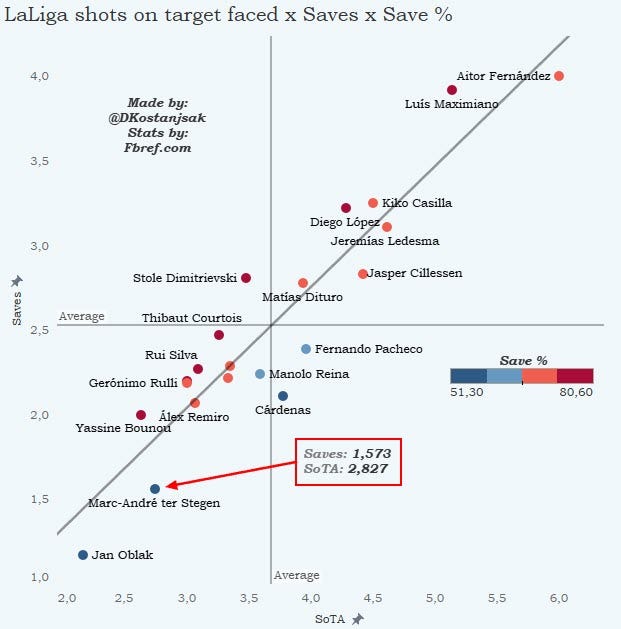
As things currently stand, the German goalie is only above Jan Oblak in this category. But it’s more natural for goalkeepers to tally more saves if they face more shots. Ter Stegen, for instance, faces only 2.8 shots on target per 90 minutes, which is a far cry from Aitor Fernández’s six or Luís Maximiano’s 5.14. However, the fact that he only saves 56.8% of shots faced does reveal some cracks in the wall. With the exception of Oblak and Manolo Reina, the rest of the goalkeepers in the lower left quadrant - or goalkeepers who face a below-average number of shots and make a below-average number of saves - have an incredibly good save percentage.
The next category I want to discuss is dealing with crosses. As a general rule of thumb, there is a slight positive correlation between being a good cross-stopper/claimer and goal-prevention, meaning being good in the former will slightly enhance your ability in the latter. However, I’ve found the correlation to only be rather marginal. With that being said, though, stopping crosses can generally be connected to sweeper-keepers far more since they are also more likely to leave their line and engage in duels/claims. In that regard, the correlation is rather strong - the more a goalkeeper exits their line, the better they generally are at collecting crosses. The same is true if we reverse the situation - goalies who are better at collecting crosses will come off their lines far more, thus registering more exits per 90 as well.
Alongside Manuel Neuer, Ter Stegen used to be a very good example of a sweeper-keeper. However, as we’ll shortly see, that may not be the case anymore. Just as a reminder, we can narrow goalkeepers into three general categories: the sweeper-keeper, the ball-playing goalkeeper and the line goalkeeper. There are pros and cons to all, of course, and players can fall into multiple categories at once but with his aggressive nature and good ball-playing abilities, Ter Stegen would fall somewhere between the first two. Or at least it used to be that way.
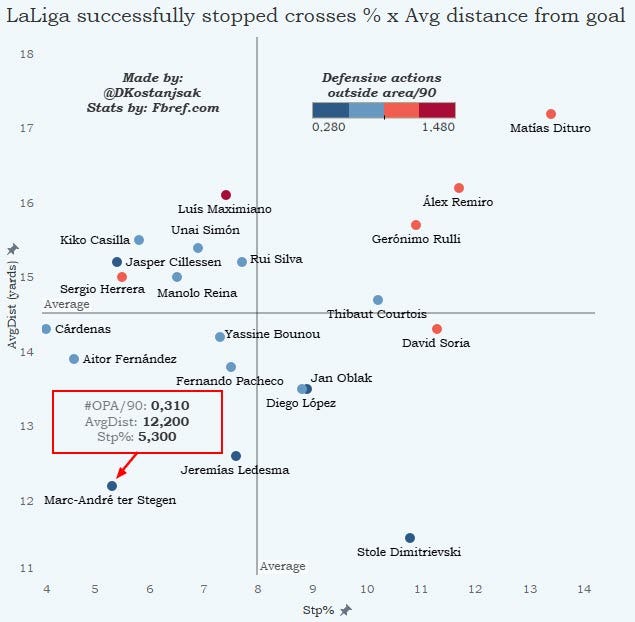
Compared to the rest of LaLiga this season, Ter Stegen once again found himself in the bottom left quadrant for the lowest average distance from the goal (AvgDist) and lowest percentage for stopped crosses (Stp%). Similarly, with dark blue depicting the fewest number of defensive actions outside of the penalty area per 90, the German is once again among the worst-performing goalkeepers on the list. And this is quite intriguing too because as it currently stands, Ter Stegen is no longer a sweeper-keeper at all. His Barcelona career-high tally of being an average of 17.1 yards away from his line dropped to his Barcelona career-low of 12.2. Similarly, his defensive actions outside of the area per 90 experienced a decline too as the German’s 0.31 are a far cry from last season’s 0.71.
And since we’ve established there is indeed a correlation between goalie exits or, in this case here, the average distance from goal, and stopped crosses, it doesn’t surprise Ter Stegen’s 5.3% is among the lowest in the league. Of course, just mentioning crosses is not enough as we still have no perception of how dangerous they were, in what situations were they deployed etc. But this data set can still tell us about Ter Stegen’s tendencies and success rate. So we’ve concluded sweeping is no longer one of his major strengths but what about passing?
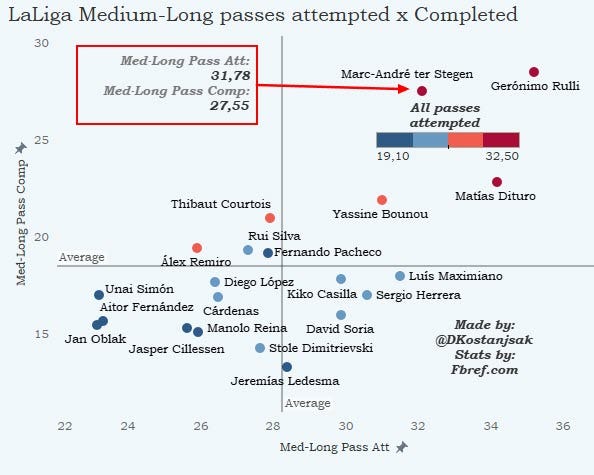
Being a Barcelona player, it doesn’t surprise to see Ter Stegen still dominate the on-the-ball category, clearly depicting him as a ball-playing goalkeeper. The graph above analyses medium and long passes attempted and completed with the colour showing us all passes attempted as well. Quite clearly, alongside the likes of Yassine Bounou, Matías Dituro and Gerónimo Rulli, Ter Stegen is good on the ball. But we already knew that to be true despite some more recent blunders in possession. This graph helps us establish the German’s profile more so than analyse his passing in detail, as that won’t be the focus of our analysis today. It has to be noted, however, that the German falls into the category of short-passing goalies and plays for a possession-heavy team, both of which play a part in his overall accuracy. The same can be said for Villarreal, Sevilla and Celta Vigo too, hence their goalies accompanying Ter Stegen in the top right quadrant.
To round up this section of our analysis, we’ll tackle probably the most interesting and most advanced data set yet - Goals saved above average percentage & shots on target saved percentage. The latter is self-explanatory but the former is a very advanced metric, premiered by StatsBomb, that essentially tells us how the goalkeeper performed versus what was expected. To get that metric (GSAA%), we’ve taken every goalkeeper’s goals and subtracted them from their post-shot xG. That number was then divided by shots faced (full formula (PSxG - Goals)/Shots Faced = GSAA%).
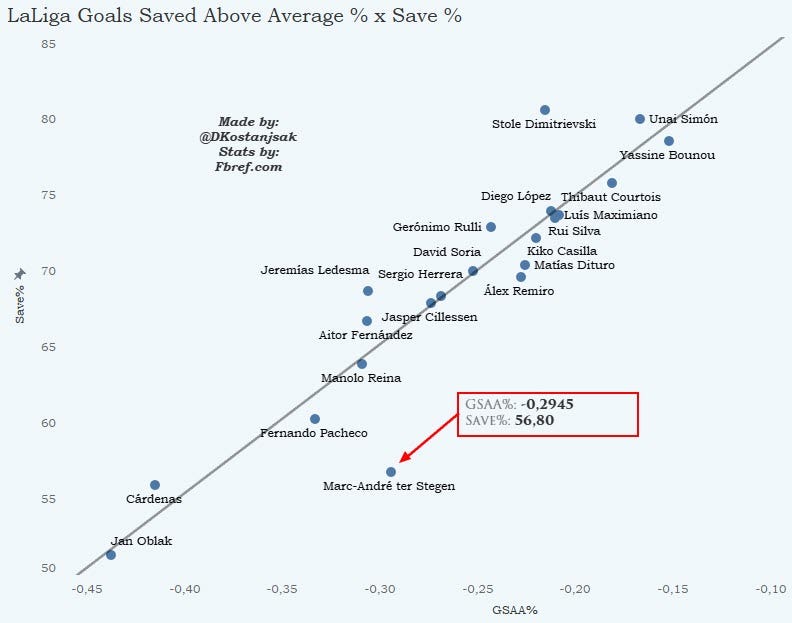
Disregarding Oblak’s tremendous decline too, Ter Stegen is once again among the poorest-performing goalkeepers in this graph. With a GSAA% at -0.29, we can conclude Ter Stegen has conceded more goals than the expected model had predicted according to the shots on target he’s faced thus far. When we break down the numbers a bit more, with 2.5 shots on target faced per 90 and 0.38 post-shot xG, Ter Stegen shouldn’t have conceded 1.19 goals per 90 so far this season.
Having consulted the data, now we know that the decline in performance is quite visible, to say the least. But while statistics can help us confirm a problem does exist, they can’t explain the nature of it. For that, we have to move on to the eye test.
(Botching) The fundamentals
I’ve talked about certain aspects that are unique to the goalkeeper position. Let’s call them goalie fundamentals for the sake of our analysis here. In this section, I will go through some of them and see whether there are some recurring issues in Ter Stegen’s execution of said fundamentals, or basics if you will. Those will include diving technique, shot-blocking and set positions. It’s important to note all of those aspects are somehow interconnected but we can isolate them for the purpose of more in-depth analysis.
Before we start, there is one more key detail I have to mention here: Ter Stegen was operated on his right knee last year and it is my belief that this is affecting his performances quite a lot. Let’s go ahead with the diving technique. When goalkeepers jump to either side, there are a couple of things you can focus on. Firstly, they will generally always use the near-side foot as their springboard - using the left leg to jump to the left and using the right leg to jump to the right. In doing so, the weight is shifted predominantly on that side and it allows for a significant boost in jumping power as opposed to trying that with the opposite foot. Similarly, it helps in getting the body in a horizontal position, covering more ground. Along those same lines is the hand choice.
Generally, it all depends on the height and the distance of the shot faced. If a goalkeeper is facing a shot that requires maximum reach and/or a shot of low-to-medium height, the low or bottom hand (left if diving towards the left) is used to save it. However, for high shots, goalies use the high or top hand (right if diving towards the left) as it allows for a better vertical reach. There are exceptions, of course, but as a general rule of thumb, this is the most effective approach. Trying to save a high shot with your low hand requires far more shot-stopping power and a much more powerful jump in the first place. So the hand choice is determined by the distance a goalie can cover when jumping and the trajectory of the ball. Finally, we have the usage of both hands, which adds more power to the shot-stopping ability but can only be used for low and medium height shots as it limits the reach.
Watching Ter Stegen’s clips, I did notice some inconsistencies in his technique but one thing that particularly caught my eye is where he tends to concede goals the most. Of course, unique scenarios will always create unique results but a good number of shots that he failed to stop were indeed targeted to his right side.
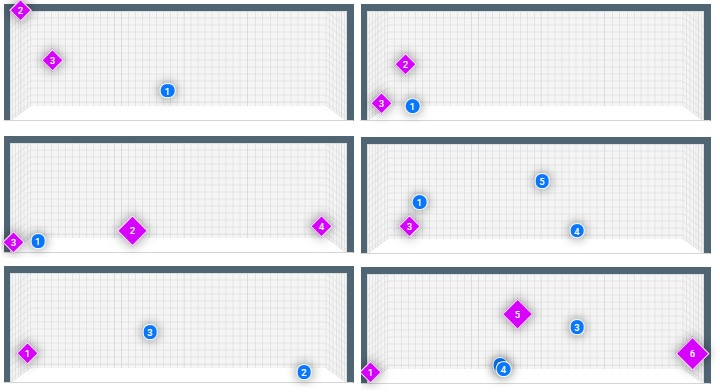
The image above shows us six different shots faced graphs from some of the more recent games he’s played. Notice anything interesting? A big number of them have indeed targeted Ter Stegen’s right side. So why is that? It all has to do with jumping power from his right leg. The majority of the goals above would require a lot of distance from the jump as they were shots that nearly scrapped the post. Lately, these prove rather difficult for the German goalkeeper to stop. Why?
Looking at some of the clips, I’ve noticed that Ter Stegen no longer has the power to cover a lot of ground using his right foot as the springboard to make the save. It’s very likely this has to do with his surgery. Before, he was extremely athletic and could dive to either side with speed and power, especially to the right. But now, the distance he can cover with his right foot has diminished greatly. Equally, sometimes he will even prefer not to use it at all or just use it sparingly to avoid putting more strain on it.
Let’s look at a couple of examples below.
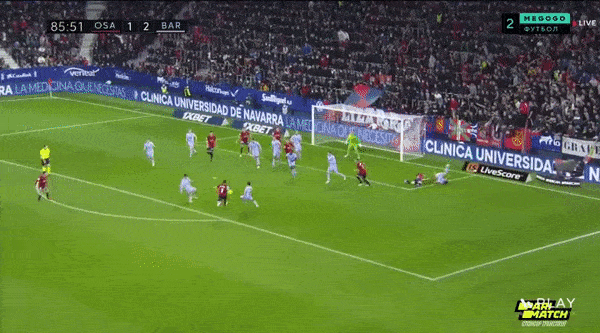
This first one shows us Ter Stegen attempting to dive to the right but seemingly using his left to add more power as opposed to the more traditional dive right with your right technique. This is also closely connected to him being extremely cautious when using the right foot due to the surgery. Notice that he couldn’t reach the ball and didn’t cover enough distance with that rather limited jump towards the right side. Trying to save a low right-sided shot with your low hand is the proper technique but he lacked both the speed and the power to stop the shot.
I will talk about shot-stopping a bit more in just a second but when watching this clip, we have to make note of Ter Stegen’s set position. This is another fundamental aspect of goalkeeping and it essentially outlines a set stance you take in preparation to make the save. A set position can very much be a thing of preference but generally, there is an aspect most goalkeepers would agree on: your feet should always be narrow, not wide. The reason behind that is that when a goalkeeper makes a save, he must generally always come forward to some degree. In other words, he has to take a step, usually at a 45-degree angle and towards the path of the ball. The narrow stance allows for this to happen while a wide stance would make it difficult to execute.
However, some modern goalkeepers like David de Gea, for example, have shown a preference towards a wide stance in a set position. Ter Stegen is the same. In most scenarios, the German will adopt a rather wide set position. Is this inherently wrong? Not necessarily. By keeping a wider stance with his feet, the goalkeeper can react sooner. Usually what will happen is that goalies will kick their leg out, allowing them to already be midway into their dive when the shot is deployed. At that moment, the opposite leg will push out towards the direction of the shot, meaning the dive starts way sooner. However, this comes at a cost of distance. In other words, the wide stance sacrifices distance for speed.
Interestingly, if you pause the above example the second the ball leaves the attacker’s foot, you’ll notice Ter Stegen is in a narrow set position, meaning he noticed distance would be required to save the attempt. In that regard, the choice was good but the diving technique was off. For some reason, he opts to use his left foot to power up the jump or at the very least, adds very little power from the right, resulting in almost no distance covered, ultimately failing to save the shot. Again, could be a sign of consciously avoiding the right foot?
Let’s look at a slightly different example next.
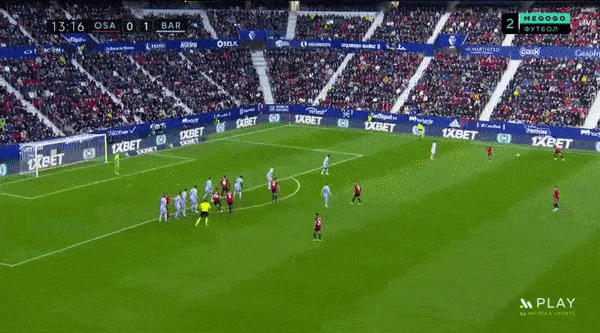
Disregarding that the header was excellent, this clip still shows Ter Stegen diving to his right side with the right foot and trying to save a low shot with the low hand. As far as technique goes, this is good. However, even with him ending the dive at the far post (mostly due to sliding on the ground), the power to properly boost himself wasn’t there. Again, this might be due to his right now generally generating less power than before, resulting in a short dive, or his wide set position limiting the distance he could cover with the jump.
This time, when you pause the video the moment the ball leaves the attacker’s head, you see Ter Stegen in a wide set position. As we’ve concluded earlier, this trades distance for speed. However, in this case, the German fails to reach the ball, also lacking the distance to make the save. It has to be said that generally, for shots from close range, speed is usually more necessary if the goalie is not in an optimal position between the sticks. Ter Stegen being positioned too much to his left meant this save actually required both distance and speed while he could only opt for one. But we also have to complicate things here once again. While the wide stance helps you save short-range shots and shots that are aimed close to the goalkeeper faster, it actually sacrifices speed if the shot requires you to cover a lot of ground too.
By having your feet too wide apart, you lose the quickness and general speed of movement. Yes, you can react faster if you can mostly stay still or cover less distance but it will limit you greatly if you have to move across your line. That’s why a more balanced, narrow stance is usually preferred by most goalies. Of course, the extra step this stance requires you to make means that some won’t have the speed to execute it, especially for short-range attempts. In that case, they kick out their foot and collapse to the shot instead.
It’s actually quite intriguing to analyse the German’s set positions as he seems to struggle choosing the right one and predominantly relies on the wide stance.
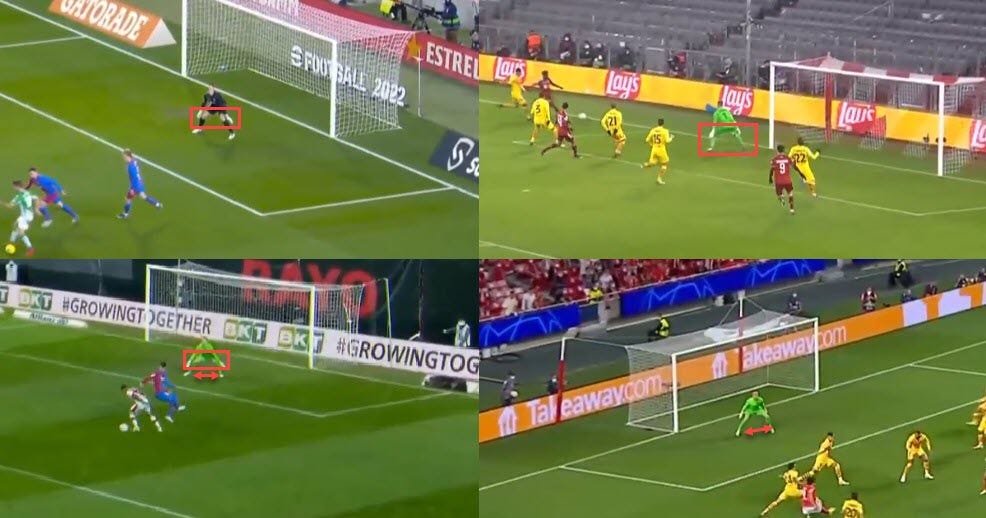
I found this to be true both pre and post-surgery too. His feet are always very wide apart and his arms are not in an ideal position. Young goalkeepers are usually always taught ‘the rule of four’ by their coaches. This rule helps them remember that their shoulders, hands, knees and feet should generally always be relatively parallel. If your feet are too wide or too narrow, you lose speed and/or your balance, which could be affecting Ter Stegen’s performances. When you pair this up with inconsistencies in pure technique, you get recurring issues.
Seeing some great saves from the Mallorca and Granada games, many wondered whether the German was indeed coming back to his very best. However, both of those admittedly great saves come with certain caveats. The first one was indeed a reflex save from close range but Ter Stegen used his arm/shoulder so didn’t have to fully rely on mustering strength onto his hand despite using his right leg as the base. The second one was arguably even more impressive but it was also a shot that suited his wide set position much more. Since the attempt was aimed relatively close to Ter Stegen and didn’t require him to cover a lot of ground and amass a lot of power doing so, the save could be achieved just by reflex and speed alone, hence needing a collapse on the ball from a wide set position.
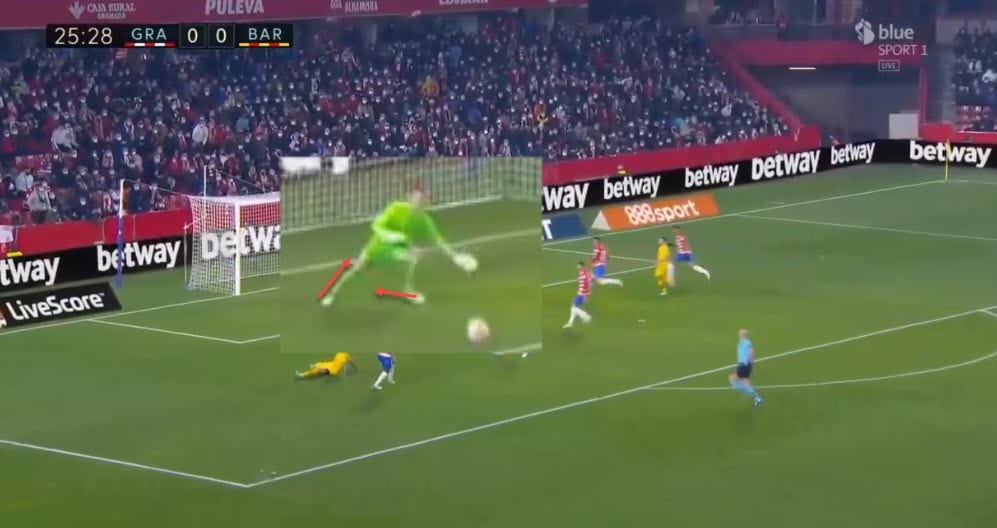
You can see the save against Granada above. He assumes a very wide set position, which allows him to start the dive sooner. As the ball approaches him, Ter Stegen kicks out his closer foot and pushes the other in the direction of the shot. This is a proper wide set position technique for shots that require fast reflex saves and are aimed near to the goalie. From that, we can conclude Ter Stegen can still make great saves that don't require big leaps to either side, especially the right. This is mostly due to the aforementioned overreliance on wide stances which add speed but sacrifice distance but also due to the effects of the surgery.
But analysing his saves both pre and post-surgery, he would often make saves purely on athleticism too. In other words, he would make low or medium saves with the high hand or even higher saves with the low hand, diverging from the standard technique. But before surgery, he had the power to compensate for that. Now, however, with some power loss, especially in the right leg, this is no longer enough to cover up for what is, at times, poor technique.
But there’s more to it. As mentioned, against Mallorca, the German made a last-ditch hero save with one hand, which used to be a trademark of his. However, more recently, and despite that brilliant exhibition of strength and speed, his shot-stopping hasn’t been as good as usual. I believe this to once again be closely tied to his surgery. Let’s take a look at two good examples of shots going through his hand.
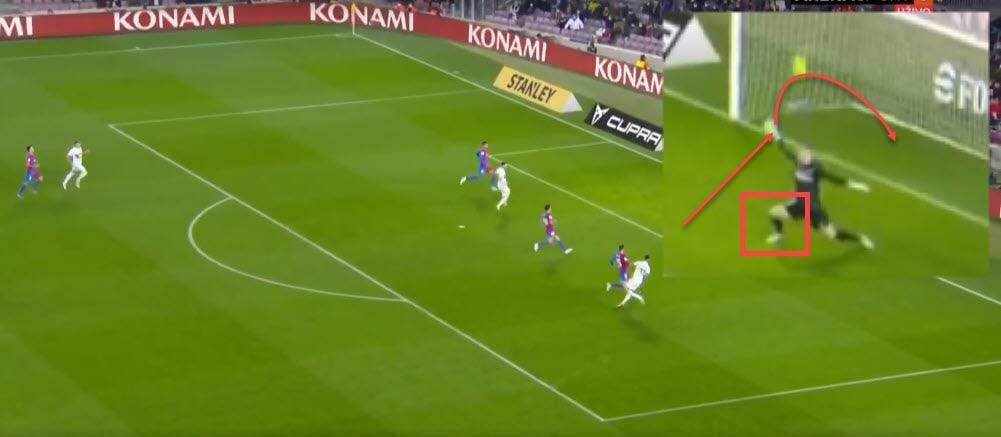
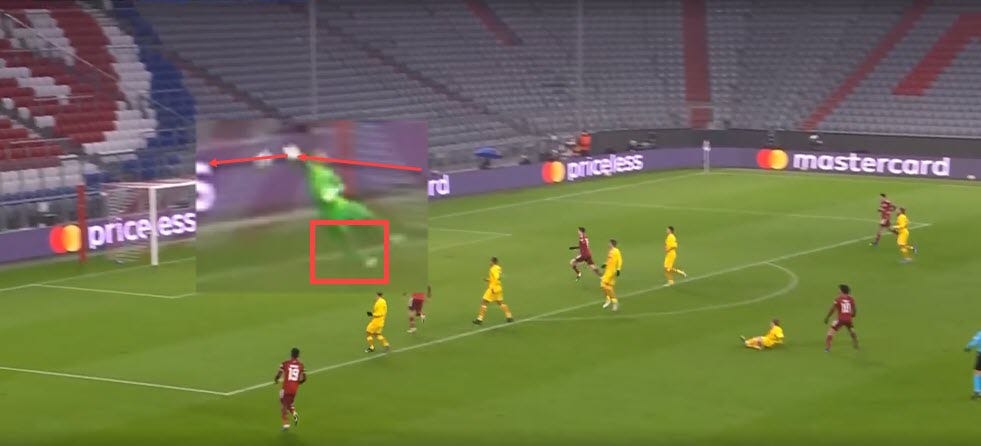
Notice that in both instances the save was attempted with his right hand while also using the right foot as the base. This also means the weight is shifted onto the right side but if he doesn’t have the strength to support the whole weight of the body anymore, it arguably affects how solid his right hand is while attempting to stop powerful shots. Of course, sometimes the shot is simply too good and the goalkeeper has absolutely no say in the goal. But when the attempt goes through the hand, it could signal a lack of strength.
Having a strong base with your weight properly supported by the stronger leg is key to having a stable stance and subsequently, to be able to stop powerful shots. But Ter Stegen also loves to hop around while waiting for the shot to be attempted. Bouncing on your toes is risky because it can result in being wrong-footed or having to use the wrong foot as your springboard when diving.
All in all, analysing goalkeepers is really very difficult. We also shouldn’t disregard the psychological toll of the surgery and Barcelona’s overall poor performances prior to Xavi’s appointment. A lot of it surely can be in the head. But there is also no escaping the fact Ter Stegen’s technique is inconsistent and before, he could make up for it through sheer athleticism and power. Now, however, with a lot less strength at his disposal, it’s getting difficult.
It’s not impossible that a boost in morale will result in performance enhancement but ultimately, perfecting the fundamentals and working on his technique would potentially yield much better results. The way back is long but not unachievable.
Let’s hope he makes it.

